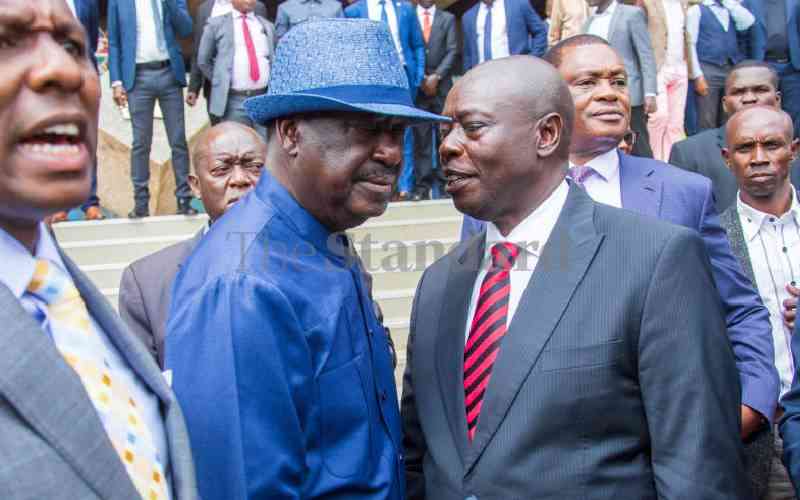I have had both the pleasure and displeasure of being part of the audience of more than a few fashion shows in Nairobi.
Two things often stand out in such events — the sure-fire ambition of upcoming designers, and the numbing familiarity of the set. It is habitually not a show-stopping script, to the point of being stereotypical.
How do you pull off a production that entertains jaded, seen-it-all audience that attend countless fashion shows, or the inescapable retinue of photographers and journalists who make the wake of fashion shows?
That’s the question local organisers of fashion events should not strut around.
And the answer is readily available from imaginative producers, like Sandra Choi, who transformed a London gymnasium into a full-scale skate park for the debut of Jimmy Choo men’s 2015/2016 collection at the London Collections: Men, last month.
It was a meld of the influence of traditional styling with contemporary everyday wearability of sportswear. But it is the presentation that captured the imagination, with professional skateboarders and BMX riders pulling stunts that your regular “left-right” swaying model cannot execute on the catwalk. Now that is a show in every sense of the word.
It beats logic to showcase sportswear as part of your marketing strategy, then subject your audience to a dreary catwalk parade of sissyish, smooth-skinned models with physiques that are anything but sporty.
We can borrow a leaf from Jimmy Choo, even if it threatens the overstaying scrawny models, to usher in a new era of runway stars with skills that can challenge any stunts man.
After all, what you wear has to be both fit for purpose and true expression of your personality, and a boney model’s thigh gap or waistline might not necessarily bring that home.
Kenyan fashion shows sadly tend to have a zombie-like shuffle to the bottom line reality that new age experiential marketing is leaving laggards threadbare in a cut-throat race that will shunt the passive “look-at-me” promotions to oblivion.
It is the reason that even magazine advertisements are losing their appeal to artistes like Sauti Sol who have been contracted by Tusker Lite in local club tour campaigns, or through international musicians like Anthony Hamilton.
Perhaps it is the industry’s uppity, tight-lipped airs of a “suave” class, that has stitched us into complacency.
Because fashion is a visual art, its consumption and packaging must always be engaging with a deliberate and clear narrative, at least as far as fashion shows are concerned. Dance troupes learnt this a long time ago.
That is why ballerinas tell stories with their moves and artists have interactive installations to break the stillness of gallery exhibitions.
It is also why the Nairobi-based FBI Dance Crew won the Faites Danser Le Monde world dance competition in France in June. They choreographed their routine to tell the story of the Garissa University College terrorist attack.
Stay informed. Subscribe to our newsletter
So, what is the story behind that flounce on a typical elevated and narrow runway platform in a kitenge that my local fundi can probably cut and run up far much better. If the design is not as awe-inspiring as a Versace or Armani, why not captivate your audience in a way they can relate, the way musicals re-energised plays and closed the curtain on the robotic loudness of drama, characterised by the causeless gestures of “acting.”
I look forward to the day that some designer, with the help of a creative producer, will charm fashion lovers by transforming the railway museum into a leitmotif presentation that brings into play the venerable quaintness of the old wagons and tracks, instead of just limiting it to location shoots for fashion magazines.
Regardless of a fashion show’s theme, whether it is grounded on boho vibes or a dominatrix-esque boldness of bondage designs, the show will not be going on for discerning participants in the audience.
What Kenyan designers and fashion event organisers first need to appreciate is the crucial role of fashion show producers.
Our fashion shows must be dynamic and entertaining with high impact on the audience.
I would love to attend a show that will captivate and leave me with a lasting impression, and not just a procession of skinny models with weird hairdos and quirky clothes.
Great fashion shows artistically fuse (the) themed and memorable productions that are not entirely anchored by attires and the makeup of models.
In any case, the new generation needs more role models than supermodels.
The bog-standard productions we have been treated to for ages sometimes hearkens to the corny creations of our designers.
These productions have a phoney nuance that makes it hard to shake the feeling that something is off, not unlike the disconcerting sandpapered Dracula look of Caitlyn Jenner’s artificiality.
Twitter: @omondipaul
 The Standard Group Plc is a
multi-media organization with investments in media platforms spanning newspaper
print operations, television, radio broadcasting, digital and online services. The
Standard Group is recognized as a leading multi-media house in Kenya with a key
influence in matters of national and international interest.
The Standard Group Plc is a
multi-media organization with investments in media platforms spanning newspaper
print operations, television, radio broadcasting, digital and online services. The
Standard Group is recognized as a leading multi-media house in Kenya with a key
influence in matters of national and international interest.
 The Standard Group Plc is a
multi-media organization with investments in media platforms spanning newspaper
print operations, television, radio broadcasting, digital and online services. The
Standard Group is recognized as a leading multi-media house in Kenya with a key
influence in matters of national and international interest.
The Standard Group Plc is a
multi-media organization with investments in media platforms spanning newspaper
print operations, television, radio broadcasting, digital and online services. The
Standard Group is recognized as a leading multi-media house in Kenya with a key
influence in matters of national and international interest.





